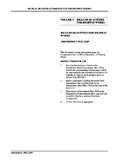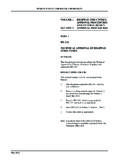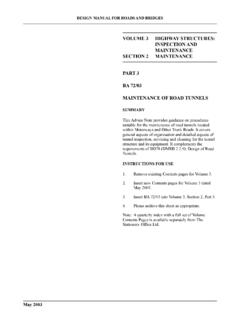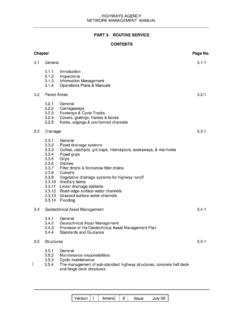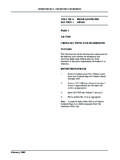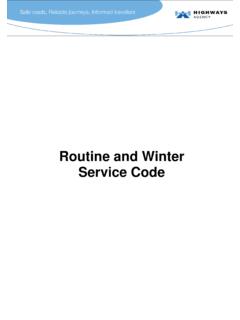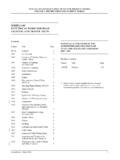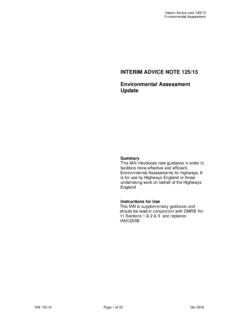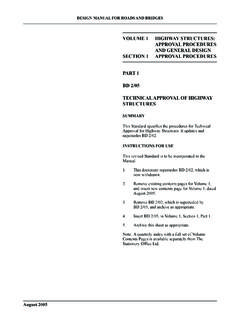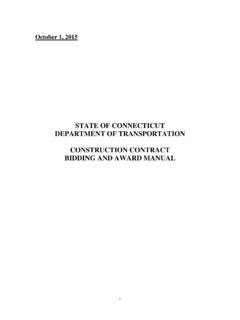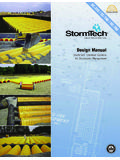Transcription of MANUAL OF CONTRACT DOCUMENTS FOR …
1 MANUAL OF CONTRACT DOCUMENTS for highway WORKS. volume 2 NOTES FOR GUIDANCE ON THE SPECIFICATION for highway WORKS. SERIES NG 1000. ROAD PAVEMENTS . CONCRETE MATERIALS. Contents Clause Title Page Clause Title Page NG 1000 (02/16) General 2 NG 1030 (02/16) Wet Lean Concrete 13. NG 1001 (02/16) Strength Classes of Concrete and NG 1043 (02/16) Foamed Concrete 14. Constituent Materials for Pavement Layers 2. NG 1044 (02/16) Pavements with an Exposed NG 1002 (02/16) Air Content 4 Aggregate Concrete Surface 14. NG 1003 (02/16) Density 5 NG 1045 (02/16) Weather Conditions for Laying of Cementitious Materials 15F. NG 1004 (02/16) Pavement Concrete Strength 5. NG 1048 (02/16) Use of Surfaces by Traffic and NG 1005 (02/16) Consistence (Workability) 6. Construction Plant 15F.
2 NG 1006 (02/16) Not Used 7. NG (02/16) CONTRACT Specific Appendix A1F. NG 1007 (02/16) Separation and Waterproof Membranes 7. NG 1008 (02/16) Steel Reinforcement 7. NG 1009 (02/16) Transverse Joints 8. NG 1010 (02/16) Longitudinal Joints 8. }. NG 1011 (02/16) Placing and Inspection of 8. NG 1012 Dowel Bars and Tie Bars NG 1019 NG 1013 (02/16) Joint Grooves 9. NG 1015 (02/16) Joint Filler Board 10. }. NG 1016 (02/16) Preparation and Sealing . NG 1017 of Joint Grooves 10. NG 1018 (02/16) Joints at Manhole and Gully Slabs 11. NG 1020 (02/16) Side Forms, Rails and Guide Wires 11. NG 1021 to NG 1023 (02/16) Not Used 11. NG 1024 (02/16) Construction by Machine 11. NG 1025 (02/16) Construction by Small Paving Machines or Hand Guided Methods 12. NG 1026 (02/16) Finished Surface Requirements 12.
3 NG 1027 (02/16) Curing 13. NG 1028 (02/16) Trial Lengths 13. NG 1029 (02/16) Texturing of Hardened Concrete 13. Amendment February 2016 1. volume 2 Series NG 1000. Notes for Guidance on the Specification for highway Works Road Pavements Concrete Materials ROAD PAVEMENTS CONCRETE MATERIALS. NG 1000 (02/16) General 1 (02/16) Advice on the design, construction and maintenance of concrete roads and for concrete mix design is published in Standards and Advice Notes and Design: The Design MANUAL for Roads and Bridges (DMRB), volume 7. Construction: Mechanical Construction of Concrete Pavements and Ancillary Works, Concrete Society, Technical Report No. 45. Mix Design: Design of Concrete Mixes, SO, 1988. Remedial Works: Concrete Pavement Maintenance MANUAL published by the Concrete Society 2 (02/16) The pavement design requirements for concrete pavements should be based on the Design MANUAL for Roads and Bridges volume 7 and shown in CONTRACT specific Appendices 7/1 and 10/1.
4 3 (02/16) The philosophy for compliance has now changed to that of an end performance requirement of the finished pavement with cores being taken and assessed for density and compressive strength as specified in BS EN. 13877-2. This is supplemented by determination of the air voids in the concrete, minimum cement content, control of the water cement ratio and use of suitable materials for durability purposes. There is no assessment of concrete cubes for compliance, however, the Contractor may wish to operate an early age cube testing regime for concrete control purposes. 4 (02/16) With the use end performance specifications, subject to meeting the requirements of the specification, the choice of construction methods and consistence should solely be that of the Contractor.
5 However, the exception to this would be for the final regulation of concrete surface slabs where the use of a longitudinal oscillating float is required to provide necessary evenness prior to macro texture being applied. The requirements for pavement construction details and location of joints should be accordance with this Series. 5 (02/16) For small contracts, and with the agreement of the Overseeing Organisation, the requirements of BS. EN 13877-1 may be employed with a recipe specification, compliance by cube testing and density complying with Clause 1003. With a recipe specification the method of construction should comply with the requirements of this Series. 6 (02/16) For new construction and major maintenance the end performance specification should be used.
6 The pavement should meet the requirements of BS EN 13877-2 and Clauses 1001 to 1004 are the appropriate Clauses for assessment of the pavement quality and wet lean concretes. NG 1001 (02/16) Strength Classes of Concrete and Constituent Materials for Pavement Layers 1 (02/16) Clauses 1001 and 1002 give the requirements for constituent materials and limits for designed concrete in the form required in BS EN 206-1, BS EN 13877-1, BS EN 13877-2, BS 8500-1 and BS 8500-2. 2 (02/16) Six strength classes of concrete are included to meet the needs of sub-bases, bases with flexible surfacing, continuously reinforced concrete bases with flexible surfacing and slabs in the pavement surface. 3 (02/16) The strength classes for pavement surface concrete has been selected to provide greater durability for increasingly heavy traffic.
7 4 (02/16) The minimum cement or combination content is given in BS 8500-1 Table A18 and is dependent on the maximum aggregate size in the concrete. 5 (02/16) In addition to Portland cement CEM I, the term cement' includes other hydraulic binders such as combinations of CEM I and ground granulated blastfurnace slag (ggbs) and pozzolanic cements such as blends of CEM I and pulverised-fuel ash (pfa), whether they are blended on site or manufactured by blending or intergrinding. These include Portland blastfurnace cement, Portland CEM II/B-V cement and pozzolanic pfa cement. Amendment February 2016 2. volume 2 Series NG 1000. Notes for Guidance on the Specification for highway Works Road Pavements Concrete Materials 6 (02/16) Portland limestone cement should not be used in the top 50 mm of the road surface, as this would increase the fine calcium carbonate content and lead to slipperiness.
8 Microsilica may be used with CEM I to obtain high early strength concrete. 7 (02/16) For durability it is necessary to have a water/cement ratio below for pavement surface slabs. The water/cement ratio is defined as the ratio of free water to total cementitious content of the concrete. 8 (02/16) High early strength Portland cements should only be used where rapid construction is required. In such cases, insulation blankets will be required over the concrete to provide suitable curing conditions which will reduce the risk of thermal cracking of the concrete. 9 (02/16) High early strength cements, high cement contents and low water/cementitious ratios may be used when there is a need to open a section of concrete pavement to traffic early. Prescribed concretes of fixed proportions may be used in rapid construction for high early strength concrete.
9 The proportions of ingredients to be used should be decided by trial concrete mixes which when tested provide the quality, consistence and strength development required for the particular application. 10 (02/16) Both CEM I /pfa and CEM I /ggbs concrete have a long term increase in strength greater than CEM I concretes for the same 28 day strength and provide greater durability and resistance to chemical attack. However, there is evidence that all but the strongest concretes in the top 50 mm of a road pavement which contain more than 25% pfa or 35% ggbs are more likely to suffer from damage under freeze/thaw conditions, and is the reason the amount of pfa and slag is limited to these values. If pfa is included in the concrete it permits lower water/. cement ratios for a required consistence, so providing denser concrete of lower permeability and greater durability.
10 (02/16) Admixtures 11 (02/16) Air entraining agents are essential in all but the strongest pavement surface slabs to reduce freeze/thaw damage. Asphalt material provides some protection to concrete slabs and air entraining agents are not necessary unless the concrete is to be exposed to freeze/thaw cycling before the surfacing is applied or before the concrete has gained sufficient strength. A small loss in strength is to be expected with air entrained concrete compared with plain concrete with the same mix proportions. 12 (02/16) Plasticisers can be used to reduce water in the concrete, increase strength and maintain consistence at the required level. They can be beneficial in concretes with blends of CEM I with ggbs or pfa, as the water reduction partially compensates for the loss of early strength.
